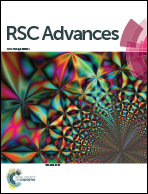Preparation of SnO2 nanotubes via a template-free electrospinning process
Abstract
A facile and environmentally friendly template-free method is developed for the fabrication of SnO2 nanotubes via electrospinning and precisely controlled heat treatment method. It is revealed that the as-spun solid SnO2 precursor fibers gradually transformed into hollow-structured nanotubes when the temperature was controlled precisely from 200 °C to 600 °C. It was confirmed, that this remarkable structural evolution corporate the respective thermal decomposition of polyvinyl butyral (PVB) at the surface and inside of the fibers. The formation mechanism of the nanotubes has been clarified by systematically investigating the morphology, phase structure, chemical state, and decomposition of the organic compounds during the heat treatment. The as-prepared SnO2 nanotubes exhibit a high specific surface area of 32.91 m2 g−1 and a porous structure with pore sizes of 2 nm and 10–25 nm. The SnO2 nanotubes were assembled as a photosensor, which demonstrates a fast response upon UV light illumination at 254 nm. From this discovery, it is expected that a new method for fabricating nanotubes will be established and the development of materials with a higher functionality will be promoted.



 Please wait while we load your content...
Please wait while we load your content...